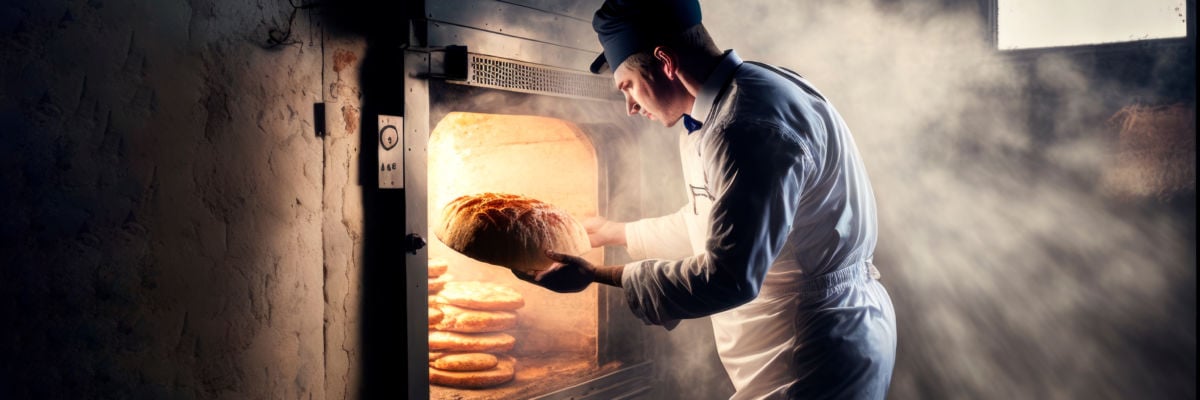
In the introduction to his classic Catholic Catechism, Fr. John Hardon describes well the perennial challenge of the Catholic Church to strike a balance between the manifold and false “either/or” propositions that constitute the great heresies and errors of Church history and what Fr. Hardon called the truth of “the eternal and.” For example, the pantheist says the universe consists of God alone. The material is mere illusion. The materialist says it is all and only matter. The truth is, it’s both. The Protestant says we are saved by “faith alone”; the various Pelagian sects say it is by “works alone.” The truth is, it’s both. The Monophysite says Jesus is God alone; the Arian (or the Jehovah’s Witness today) says he is man alone. The truth is, he’s both. The list could go on and on.
So it is with the Eucharist. For many, there are only two options. Either it is a symbol or it is Jesus. I know this was my thinking when I was Protestant. “When Jesus says, ‘This is my body,’ or ‘Unless you eat the flesh of the Son of Man,’ it is obvious he is speaking symbolically,” I would say. “Bread and wine were to nature what Jesus Christ is to our super-nature. Bread and wine are obviously excellent symbols of Jesus Christ.” In my mind as a Protestant, if I could show communion to be symbolic, I had proved my point. The idea of “both/and” was never even a consideration.
The Protestant error concerning the Real Presence here is easy enough to correct. And the Catholic will be rightly and understandably quick on the draw to demonstrate the literal sense of Jesus’ very plain words in both the institution narratives and in John 6. But be careful, my Catholic friends! The Catholic can present great points for the real presence of Our Lord in the Eucharist, and win an important battle, but lose the war by denying there to be any symbolic value to Our Lord’s words at all. The error in this reasoning can tend to be all his Protestant counterpart will hear. And it is an error, to be sure.
Moreover, a well-read Protestant can present writings of multiple Fathers and Doctors of the Church, from Tertullian, St. Clement of Alexandria, and St. Augustine to the “Common Doctor” himself, St. Thomas Aquinas, replete with references to our Blessed Lord’s words—“This is my body. . . . This is . . . my blood”—as being “figurative,” “signs,” or “symbolic.” Now, of course, each of these great teachers throughout Church history will also teach that the Eucharist truly is what it symbolizes. But to many, like myself as a Protestant, the Catholic denying the truth of the symbolic reality of the Eucharist—and in so doing, denying what is evident in Scripture—will drown out all other good points made.
Listing examples from each of these Fathers and Doctors is beyond the scope of this brief article, but for our purpose, we need only reference the Catechism of the Catholic Church to find magisterial use of the terms sign and symbol to describe the Eucharist (1148, 1412) alongside many more examples declaring the real presence of Our Lord in the Eucharist (1373-1381). The Council of Trent, Session 22, Chapter 1, does the same:
Declaring himself constituted a priest forever, according to the order of Melchizedek, he offered up to God the Father his own body and blood under the species of bread and wine; and, under the symbols of those same things, he delivered [his own body and blood] to be received by his apostles, whom he then constituted priests of the New Testament; and by those words, “Do this in commemoration of me,” he commanded them and their successors in the priesthood, to offer [them]; even as the Catholic Church has always understood and taught.
The Catholic Church has always understood the Eucharist both to employ “figures” or “symbols” and to be God’s instrument to communicate the body, blood, soul, and divinity of Christ, in his substantial reality, under the accidents or appearances of bread and wine to the people of God for their spiritual sustenance. Once again, the answer is both/and.
The Catholic evangelizer will inevitably face another “either/or” proposition when it comes to the Eucharist: “The communion the New Testament speaks of is simply a memorial of Christ’s sacrifice that occurred 2,000 years ago, and nothing more. Jesus said, ‘Do this in memory of me’ in Luke 22:19. It can’t be Christ and a memorial of Christ at the same time any more than the Thomas Jefferson Memorial in Washington, D.C., could also be Thomas Jefferson!”
How do we respond?
We ought to emphasize as Catholics that the Catholic Church agrees with our Protestant friends on this point. Jesus is unequivocal in Luke 22:19, as I cited above: “Do this in memory of me.” Catholics believe the word of Christ. The Eucharist is the same sacrifice that was offered 2,000 years ago inasmuch as it is the same priest and the same victim being offered, but at the same time, it is offered in a different manner—an unbloody manner. Thus, it is truly a memorial of the “once for all” bloody sacrifice of Christ offered in a unique manner 2,000 years ago (Heb. 10:10). As such, the sacrifice of Christ can never and will never be offered in a bloody way again!
CCC 1367 provides the following:
The sacrifice of Christ and the sacrifice of the Eucharist are one single sacrifice: “The victim is one and the same: the same now offers through the ministry of priests, who then offered himself on the cross; only the manner of offering is different.” “And since in this divine sacrifice which is celebrated in the Mass, the same Christ who offered himself once in a bloody manner on the altar of the cross is contained and is offered in an unbloody manner . . . this sacrifice is truly propitiatory.
Because the Eucharist is both a memorial of what Christ did 2,000 years ago in a singular way and his true and real presence for his people, CCC 1357-1358 can say,
We carry out this command of the Lord by celebrating the memorial of his sacrifice. In so doing, we offer to the Father what he has himself given us: the gifts of his creation, bread and wine which, by the power of the Holy Spirit and by the words of Christ, have become the body and blood of Christ. Christ is thus really and mysteriously made present.
We must therefore consider the Eucharist as:
- thanksgiving and praise to the Father;
- the sacrificial memorial of Christ and his body;
- the presence of Christ by the power of his word and of his Spirit.
So is the Eucharist a memorial, substantial reality, or both? Fr. Hardon’s “eternal and” comes to the fore once again. The Eucharist is a memorial inasmuch as it is not a bloody sacrifice as Christ’s sacrifice was 2,000 years ago—it is a memorial of that bloody sacrifice. Jesus told us so when he said, “Do this in memory of me.” The Eucharist is also truly and substantially Christ because he told us so as well. “This is my body. . . . This cup . . . is the new covenant in my blood” (Luke 22:20).
As Catholics, we believe both.



